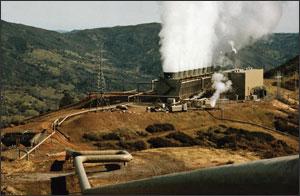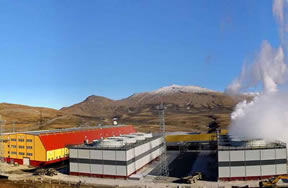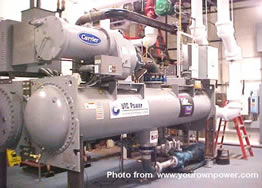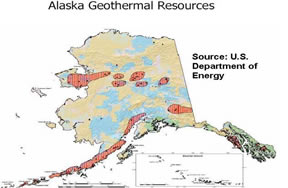An Introduction To Geothermal Energy
Could It Power Alaska Communities?
10/09/06Anchorage, Alaska
By Brian Yanity and Amanda Kolker of Insurgent49
Geothermal (or "Earth heat") energy is naturally occurring underground heat found in the form of dry hot rocks or hot water. Shallow geothermal energy sources, such as steam vents, are often found in volcanic areas. Geothermal energy can be found at the Earth's surface in some locations, in water that comes to the surface of the ground, in hot rocks miles below the surface, or in molten rock called magma. This heat is ultimately a product of radioactive decay deep within the Earth.

The geothermal energy of the Earth is diffuse and diverse, but also immense by any measure. The estimated amount of total heat flowing from the Earth's interior is equivalent to 42 terawatts of power, or more than ten times the amount of electric generation capacity existing in the world today. Geothermal energy is exploited commercially around the world, in places such as Iceland, New Zealand, the Philippines, Indonesia, Japan, Mexico, Central America, Russia, France, and Italy. Worldwide, there are almost 9,000 megawatts (MW) of geothermal electric generation capacity in 21 countries, and the equivalent of over 16,000 MW of geothermal heating capacity.
Geothermal energy potential is high in several areas of Alaska, especially on the Alaska Peninsula and along the Aleutians.
Geothermal Indirect Use: Electricity Generation
There are three major types of geothermal electricity generation:
Dry steam: uses geothermal steam directly from a geothermal reservoir such as those used in the Geysers geothermal plants of California and in Larderello, Italy. For use of steam directly from the source, it is preferable the steam be well over 200º C.
Flash steam: geothermal steam is separated from hot water and delivered to a steam turbine. Water is then re-injected into the geothermal reservoir.
Binary cycle: uses a second 'working' fluid with a lower boiling temperature than water, such as ammonia. Because steam that is lower than 200º C should not be sent through the turbine, a substance that vaporizes at much lower temperatures should be used as the medium through the turbine.
In the U.S., geothermal energy produces utility-scale electricity in California, Nevada, Oregon, Utah and Hawaii. At present, there is about 2800 MW of geothermal electric capacity in the US, making geothermal power one of the few forms of energy in which the U.S. is the top world producer. Almost half of the nation's geothermal electric capacity comes from the Geysers, which is the largest dry steam field in the world. The Geysers, about 90 miles north of San Francisco, began in 1960 and produces about 1360 MWe net. In addition, plants in California's Salton Sea produce about 570 MW total of electricity, while new facilities are in operation in Sierra Nevada range.
There are 15 geothermal power plants in Nevada, with a total capacity of nearly 275 MW, and 13 more are under development. Overall, geothermal energy provides 5% of California's electricity, and 10% of the power used in northern half of Nevada. The Great Basin region, which includes Nevada, southeastern Oregon, southwestern Idaho, Arizona and eastern Utah, is now an area of rapid geothermal development. The Puna geothermal power plant supplies 20% of the electricity needs of Hawaii's Big Island.
Western North America and Pacific islands such as Hawaii and the Aleutians owe their geothermal resource to the high degree of tectonic activity, and the resulting abundance of mountains, volcanoes, and faults. Such mountain building and volcanic activity is often associated with higher underground heat, with fault lines serving as pathways for hot water to reach the surface.
Closer to Alaska, a single geothermal power plant provides an Anchorage-sized city on Russia's Kamchatka peninsula with about one-third of its electricity. As Kamchatka is geologically an extension of the Aleutian arc, geothermal power production there serves as a direct analogue for future Alaskan geothermal projects in the Aleutians or on the Alaska Peninsula. A 100 MW geothermal power facility might be developed at the Meager Mountain-Pebble Creek area of British Columbia, about 150 km north of Vancouver.

Mutnovsky Geothermal Plant
A prime example of geothermal energy utilization is Iceland, which receives about 15% of it electricity from geothermal, and the majority of its heating. The Philippines generates almost 20% of its power, and New Zealand about 7%, from geothermal. Geothermal energy production is growing rapidly in Latin America and Asia, particularly in countries around the Pacific "Ring of Fire". Geothermal power is also growing rapidly in the Rift Valley region of East Africa. Geothermal power is projected to expand to cover 25% of Kenya's electricity needs by 2017, and correspondingly reducing dependency on imported oil.
Geothermal Direct Use: Heating and Absorption Refrigeration
The many uses of geothermal heating are also known as 'direct-use' application of geothermal, which include all uses of geothermal energy not involving electricity generation. District heating applications are a utility-scale service of providing hot water via pipes as a public service, for both radiator space heating and hot water heaters.
A district heating system provides heating for almost half of the city of Klamath Falls, Oregon (population 19,500). Such municipal-scale systems are common in Iceland, as well, where over 90% of heating energy is provided by geothermal. The island nation also boasts many large geothermally-heated swimming pools and outdoor water parks.
Geothermally-heated greenhouses are used to grow a variety of indoor crops in Iceland, including tropical fruit. Such greenhouses also used in Hungary, Italy, Idaho and New Mexico. Other possible uses include warm-water aquaculture and process heating for seafood processing. Geothermal heat can even be used to power refrigeration via an absorption refrigeration cycle. Absorption refrigeration using geothermal energy is practical for seafood or cold storage in many small Alaska communities, and has been used in Kotzebue and at Chena Hot Springs.
Challenges and Economics
While it may not be economical to extract electrical power from many of Alaska's geothermal resources, they still could be useful for heating. Many potential geothermal energy sites in Alaska are also located in remote areas, meaning that long electric transmission lines would have to be built in order to serve populated areas. Construction of geothermal power plants is capital intensive.
In 1996, it was estimated that a 15 MW geothermal power plant could be built on Mt. Makushin near Unalaska for $90 million, or $6,436 per kW of installed capacity. At the time, the capital cost of conventional diesel generation was around $500 per kW. On the other hand, like other renewable energy sources, geothermal plants have few additional long-term costs when compared to fuel-based electric power plants. They bear no fuel costs or associated transportation costs, and operation and maintenance costs are relatively minor. Despite the high capital costs, a typical geothermal plant's lifetime operating costs are much less than that of a diesel-powered facility of equivalent capacity. This disparity of operating costs is especially true during times of high fossil fuel prices.

Map of Potential Mt. Makushin Geothermal Site
Sustainability of Geothermal Energy
Geothermal energy resources (i.e. "geothermal reservoirs") require three basic components: heat, groundwater, and permeable rocks (which permit deep circulation of groundwater). Geothermal reservoirs are considered renewable because heat is constantly produced in the Earth's interior, and groundwater is constantly penetrating Earth's subsurface. Hence, geothermal reservoirs are sustainable over the long-term. Because of its heat energy, federal statutory definitions consider geothermal water, when used for heating or electricity generation, a mineral like oil or gas. Unlike these hydrocarbons, however, carefully managed geothermal systems are expected to last centuries. However, there already have been some slow declines of the heat energy in geothermal fields, as a result of energy overproduction and/or improper re-injection of spent geothermal fluids. For example, the first use of geothermal stream to generate electricity was in Larderello, Italy in 1904, a facility which is still in use today, though with less power output than before.
Many of the world's hot water reservoirs, particularly those of higher temperature and salinity, pose the potential for contamination of nearby soils if the extracted water is not re-injected into the ground. There is also the risk of aquifer disruption when large amounts of water are extracted from the ground. Although hot springs are commonly associated with the strong smell of sulfur, geothermal power plants have sulfur-emissions rates that average only a few percent of those from fossil-fuel alternatives. The newest generation of geothermal power plants emits only 0.3 lb. of carbon (as CO2) per MW-hr of electricity generated, or 1000 times lower than that for a plant using natural gas (methane) and even more for a coal- fired plant. Nitrogen oxide emissions are much lower in geothermal power plants than in fossil fuel power plants.
The hazardous nature of volcanic geothermal resources is well known, as they are often located in area with a high risk of eruption, such as Mt. Spurr. Another risk for geothermal power facilities is the corrosion of metal pipes by the minerals contained geothermal steams and gases.
Geothermal Energy for Alaska
There are four geologic regions in Alaska which contain geothermal energy:
- The "Ring of Fire" region along the Pacific Coast
- Central Alaska hot springs (from the Canada's Yukon to Seward Peninsula)
- Southeast Alaska hot springs
- Wrangell Volcanoes
Most of what is known about Alaska's geothermal resources comes from a state-sponsored exploration effort that occurred during 1971-1985. During that time, 111 resources were identified in Alaska. The majority of exploration occurred at 4 sites: Mt. Adagdak (Adak Island), Makushin Geothermal Area (Unalaska Island), Hot Springs Bay (Akutan Island), and Pilgrim Hot Springs (near Nome).
Based on these studies, Mt. Makushin is considered a "proven geothermal resource," and areas of high geothermal energy potential also exist on Akutan Island, Adak Island, and most of the eastern flank of the Alaska Peninsula. Another area of geothermal potential is thought to exist in the Mt. Spurr area, about 80 miles due west of Anchorage, and is the closest such basin to the Railbelt. Mt. Sanford and Mt. Drum near Glennallen, and Pilgrim Hot Springs on the Seward Peninsula, have also been studied as potential geothermal power sites. Since 1985, little work has been done to characterize Alaska's geothermal resource potential.
Chena Hot Springs, east of Fairbanks, and Bell Island Hot Springs, north of Ketchikan, both provide building heating with geothermal energy. Chena Hot Springs is also the home of the first installed geothermal power plant in Alaska, and the lowest temperature geothermal resource ever tapped for power generation in the world. This geothermal power plant is expected to displace 150,000 gallons of diesel per year, translating to fuel savings of at least $375,000 per year. With a total generation capacity of about 400 kW, the project cost around $2 million to build, and has received a $246,000 grant from the state government's Alaska Energy Authority. The resort's greenhouses and "ice museum" are also made possible by the geothermal heat. The greenhouse's 400 tomato plants have yielded about 1,600 pounds of tomatoes since April 2006. As described by Gwen Holdmann, the project's leader at the Chena Hot Springs Resort, "As of the end of September we have generated 115MWhrs of power, displacing 8000+ gallons of diesel. The plant has been running with 99% availability, although we have shut down for a few days to insulate pipelines and winterize the system." In the future, geothermal hydrogen production is planned for Chena Hot Springs. All of Chena's geothermal projects are described in detail on the project website (www.yourownpower.com).

Chena Hot Springs Power Plant
In 2005, Chena Hot Springs was the only site in Alaska to have received a USDOE grant to conduct scientific exploration of its geothermal resource. The exploration project is ongoing. Results from these studies should further our understanding of the geothermal resource of Central Alaska, the cause of which is still unknown.
Prospecting for geothermal energy is typically a two-phase process. The first phase involves geologic mapping (to characterize tectonic setting, permeability of reservoir, and surface conditions), geophysical studies such as seismic, gravity, and electro-magnetic surveys (to image the subsurface), geochemical investigations (to characterize the nature of the geothermal fluid), and shallow drilling for thermal gradient information. These studies help target sites for the second phase of geothermal exploration, which involves deep drilling of the geothermal reservoir.

In the Aleutians, the Mt. Makushin geothermal prospect described above has an estimated temperature of 390º F (200º C). The proposed 15 MW power plant would be located about 12 miles west-northwest of Unalaska near the base of the Makushin Volcano. Electricity lines and the district-heat pipe will connect the plant to the city of Unalaska. On the nearby Alaska Peninsula, geothermal energy potential is being explored by the Naknek Electric Association, which serves the communities of Naknek and King Salmon near the volcanic areas of Katmai National Park.

The state of Alaska is far behind other countries and even other western U.S. states in tapping available geothermal resources. However, the barriers to geothermal development in Alaska are weakening. The rising cost of fossil fuels, concurrent with recent technological advances, has significantly changed the economic viability of geothermal power in the state. The energy demand profile of Alaska is changing as well. Both direct and indirect uses of geothermal energy are much cleaner and now much less expensive (with savings as high as 80%) than the use of fossil fuels.
The geographic position of the Aleutians in the North Pacific is analogous to Iceland in the Atlantic. This suggests that Alaska could follow Iceland's lead in considering use of geothermal energy to generate and export hydrogen for the expected hydrogen economy. Also, we may anticipate increased energy needs in the Aleutians as global warming opens the Northwest Passage to shipping between the Pacific and Atlantic, or extend the season of Russia's Northern Sea Route, for which the Aleutians will become the Pacific gateway. Such developments could serve to maintain Alaska's role as an energy exporter, even as its oil and gas reserves decline.
Compared to the rest of the world's geothermal resources, Alaska's geothermal resources are poorly understood. Scientific investigations (such as the one underway at Chena Hot Springs) are needed for other geothermal sites in the state. Successfully unlocking the Earth's heat energy could help power Alaska for centuries after the last North Slope oil and gas wells run dry.
Geothermal Energy Links:
www.geothermal.org
www.geo-energy.org
geothermal.inel.gov
iga.igg.cnr.it/index.php
egi-geothermal.org
www.unr.edu/geothermal
geoheat.oit.edu
www.nzgeothermal.org.nz
www.smu.edu/geothermal/heatflow/heatflow.htm
Brian Yanity is a graduate student at UAA, activist and freelance writer. He resides in an undisclosed location in Southcentral Alaska, and can be reached at byanity@insurgent49.com.

